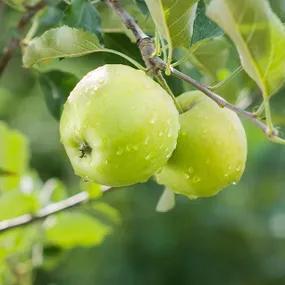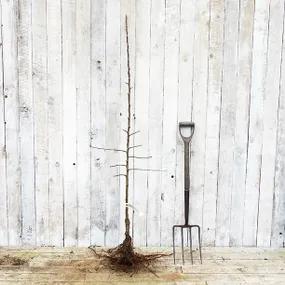Granny Smith Apple Trees
Honest Delivery Prices- Cooking & eating. Holds shape when baked.
- Pollination Group: C
- Self-fertile
- Harvest Late October
- Tip-bearer / Partial tip bearer
- RHS Plants for Pollinators
- Bareroot delivery, Nov-March
Description
Granny Smith Apple Trees: Eating & Cooking
Probably the world's most famous green apple, Granny Smith is used as a cooking apple that holds its shape when baked, and as an eater by people who love a tart, acidic flavour with a hard, crisp bite. As with pretty much any fruit, a well home-grown Granny Smith is much better than anything in the supermarket.
She stores exceptionally well, making her popular both commercially and in the garden.
Please note: To ripen consistently well, it likes a long growing season in the warmer Southern and Western parts of the country. However, it is somewhat susceptible to scab, which tends to be more of an issue in warmer areas, so it is not recommended for beginners or people looking for a really low maintenance tree.
Browse our other apple varieties, or all our fruit trees.
Delivery season: Bareroot plants are delivered late Autumn to Spring, about November-March inclusive.
Read our guide to buying apples.
Features
- Cooking & eating. Holds shape when baked.
- Pollination Group: C
- Self-fertile
- Harvest Late October
- Tip-bearer / Partial tip bearer (not recommended for cordons / espaliers)
- Recommended for Southern & Western regions
- Needs full sun
- RHS Plants for Pollinators
- Bareroot delivery, Nov-March
Growing Granny Smith Apples
Apples like a rich, well drained soil, and will thrive on clay in locations that do not get waterlogged in winter.
Granny Smith really needs her sun, and is not recommended for the North and Scotland. A warm microclimate near a wall or other structure that helps to trap heat is ideal, but as a partial-tip bearer, she is not ideal for training on wires as a cordon, espalier, etc.
She has a biennial habit, which you can reduce by thinning the crops more on bumper years.
Disease notes: Average susceptibility to scab, powdery mildew and cedar apple rust.
Rootstocks: We use MM106 for Granny Smith, the UK standard for medium-sized trees, ideal for gardeners. Grown as a half-standard, MM106 gives a tree about 4 metres tall, and as a bush about 3 metres.
Pollination Partners for Granny Smith
Your trees are self fertile, making decent crops without a pollination partner, but still perform best with one.
Granny Smith is in Pollination Group C, which cross-pollinates with other apple trees in Groups B, C and D.
Use our Fruit Pollination Checker to quickly find pollination partners, or Apple Pollination Guide to learn more.
Planting Instructions
Notes on planting apple trees:
All fruit trees like a rich soil with decent drainage, protection from the wind and plenty of sun. Apple trees like clay soil, as long as it is not prone to bad waterlogging.
Prepare your site before planting:
Improving the soil helps trees establish quickly and be productive for years. Preparing weeks or months in advance gives best results: fill the planting hole back up, don't leave it open to either dry out or fill with water.
- Destroy weeds and grass,
- Dig the soil over, remove stones, then mix in well rotted compost or manure down to the depth of about 2 spades, unless you are on heavy clay:
- On thick clay soil, only dig over the soil to break it up. Apply organic matter as a mulch over the soil after planting.
Spacing apple trees:
- Freestanding bushes: 15-18 feet (5-6m) between trees and rows.
- Freestanding half-standards: 18-30 feet (6-10m) between trees and rows.
In general, allow 1 more metre between rows than between trees along the row.
- Wire-trained cordons: 60-100cm apart along a row.
- Espaliers: 10-18 feet (3.5-6m) apart.
- Watch how to plant a fruit tree for a bush or half-standard.
- To grow a cordon or espalier, you need to install sturdy training wires.
Pruning apple trees:
- Maidens can be pruned in any style, including into bushes or half-standards.
- Bushes - start here when you buy a bush.
- Half-standards - start here when you buy a half-standard.
Accessories:
For bush and half standard apple trees, a tree planting pack, which includes a wooden support stake & rubber tie (a bamboo cane is enough support for a maiden), and a biodegradable mulch mat, with pegs, to preserve soil moisture stops and prevent weeds.
We strongly recommend using mycorrhizal "friendly fungi" on the roots of all transplanted trees.
Winter wash and greasebands are effective, organic pest prevention.
Did You Know?
Maria Ann Smith (1799–1870), who had emigrated with her family in 1838 from Beckley in East Sussex to Eastwood in New South Wales (a former town that is today part of Sydney), discovered it by chance in 1868. It is most likely a hybrid of a crab apple and an orchard apple.
When her husband died in 1876, their neighbour Edward Gallard, who was already growing it, bought their farm and was the first to sell it commercially (initially as Smith's Seedling), and by 1895 it had really caught on.
Since 1985, Sydney has held an annual Granny Smith Festival in mid-October.
Apple Tree Delivery Shapes:
Most of our fruit trees are delivered in up to 3 shapes (maiden, bush, and half standard), scroll up to see what's in stock.
Maiden:Unbranched tree, the most basic starting size, which you can train into the other forms (apart from mini patio trees).
Bush: Freestanding tree with a short trunk about 60cm tall. It will grow to about 3m. Ideal for small gardens.
Half-Standard: A freestanding form with a trunk about 120cm tall. It will grow into a full sized, "normal" apple tree, about 4m. Ideal for orchards, easy to mow underneath.
Cordon: Granny Smith is more of a tip-bearer than a spur bearer, so not ideal for cordons and espaliers, but a fan (which has more tips) would be fine.
Guide to Fruit Tree Sizes.




